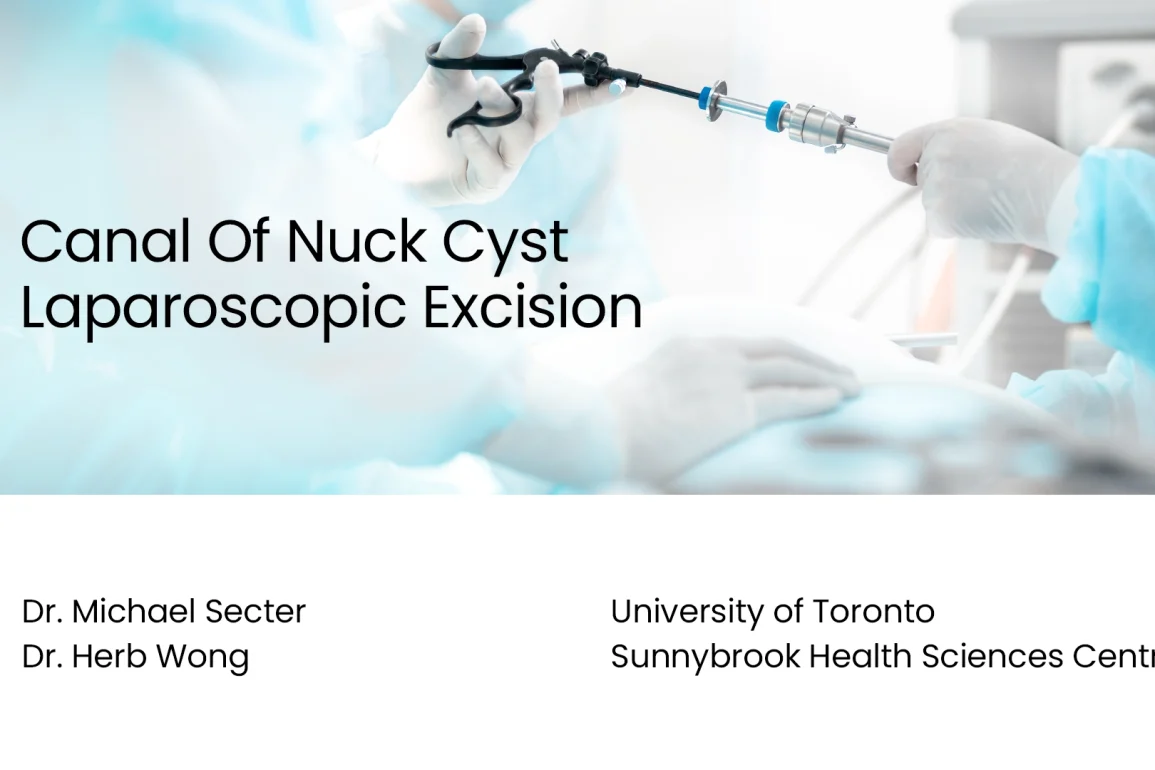Table of Contents
Summary
- The article presents a laparoscopic excision of a Canal of Nuck cyst, which is a rare but benign cause of inguinal masses in women.
- The cyst is an evagination of parietal peritoneum that accompanies the round ligament into the inguinal canal.
- The laparoscopic approach demonstrated in the video safely and effectively removes the cyst.
- The relevant anatomy includes the triangle of doom, whose medial border is the round ligament and lateral border are the gonadal vessels.
- The procedure involves dissecting the cyst away from the surrounding anatomy using a CO2 laser, and closing the defect with a running 2-0 Polysorb suture.
- The article concludes that there is little information available in the literature that guides treatment for Canal of Nuck cysts.
Presented By
Affiliations
University of Toronto, Sunnybrook Health Sciences Centre
See Also
All our laparoscopy education videos and articles.
Canal of Nuck Definition
- The Canal of Nuck is a small anatomical structure found in the inguinal region of some females.
- During fetal development, the inguinal canal allows the descent of the ovaries from the abdomen into the pelvis.
- In some females, a small pouch or canal persists after birth, which is known as the Canal of Nuck.
- It is located in the groin area, just above the inguinal ligament.
- The Canal of Nuck is lined with peritoneum, a thin membrane that covers the abdominal organs.
- While it does not typically cause any issues, in some cases, it may create a potential space leading to the development of a cyst or hydrocele, which might require medical attention or surgical intervention if they cause discomfort or complications.
Watch on YouTube
Click here to watch this video on YouTube.
Video Transcript
Canal Of Nuck Cyst Laparoscopic Excision
We present today a laparoscopic excision of a Canal of Nuck cyst. The Canal of Nuck cyst is an evagination of parietal peritoneum that accompanies the round ligament into the inguinal canal. The exact incidence is unknown, and only case reports are available for diagnosis and treatment. It is analogous to a hydrocele in men, in that it’s a congenital hernia that results when the canal fails to obliterate in the first year of life.
Clinical Presentation and Differential Diagnosis
They often are painless and non-reducible. The differential diagnosis includes Inguinal and Femoral hernias, as well as Lymphatic swellings, abscess, Lipoma, and Aneurysm. Open surgical approaches are most commonly reported in literature. Today we present a laparoscopic approach.
Case Presentation
We present a case of a 30-year-old G2P2 with two previous Caesarean sections who presents with a six-month history of symptomatic fluctuant right-sided mass. This changes with position and time of day and is non-reduceable. Ultrasound reveals a 4.6-centimeter mass suspicious for Canal of Nuck cyst.
Surgical Procedure
Exploration and Visualization
The cyst was easily visualized and palpated under general anesthesia but was even more pronounced once the creation of a pneumoperitoneum had been undertaken. The relevant anatomy includes the triangle of doom, whose medial border is the round ligament and lateral border are the gonadal vessels. In it is included the external iliac vessels, the deep circumflex iliac vein, and the femoral nerve. A review of the anatomy demonstrates the relationship between the round ligament and the major vessels in both the superior and inferior aspects.
Dissection and Excision
A vaginal assistant places pressure from the inguinal canal externally. The epigastric vessels, Canal of Nuck cyst, and round ligament are visualized when traction is placed on the round ligament on the right side. A carbon dioxide laser is used to incise the peritoneum overlaying the Canal of Nuck cyst, taking care not to rupture the cyst wall in the process.
Further dissection is performed to circumscribe the fluctuant Canal of Nuck cyst away from the overlying peritoneum. The dissection is carried out in a medial and superior fashion to avoid the epigastric vessels medially and the external iliac vessel inferiorly. Using the CO2 laser, the cyst is nearly completely circumscribed away from the surrounding anatomy. As the cyst is further dissected, rupture occurs intraoperatively towards the base of the cyst. Here it is visualized down the inguinal canal and is dissected away from the round ligament using a carbon dioxide laser.
Completion of Excision and Closure
Once deflated, the base of the cyst is seen here. The remainder of the cyst wall is excised away from the round ligament and surrounding structures using the CO2 laser. It is subsequently removed from the patient’s pelvis. A four-centimeter cyst is sent to pathology for analysis.
Once again, you can see the close proximity of the pulsating epigastric and iliac arteries. For this reason, all dissection must occur superior to the level of the inguinal ligament. In consultation with general surgery, we did not identify a concurrent indirect hernia. And therefore, no hernia repair or mesh was required at this time.
Sutured Closure
The defect is then sutured closed. A bite incorporating the inferior peritoneum, the round ligament, and the superior peritoneum is taken to obliterate the space. Great care is taken to avoid the external iliac and inferior epigastric arteries. This is accomplished by backloading the needle and suturing from an inferior to superior fashion. So that the needle tip is driven away from the vessels instead of towards them. The closure is completed with a running 2-0 Polysorb suture.
Conclusion
The completed closure is visualized here. The Canal of Nuck cyst has been completely removed, and the defect has been reapproximated. In conclusion, Canal of Nuck cysts are a rare but benign cause of inguinal masses in women. There’s very little information currently available in the literature that guides treatment. This video demonstrates that the Canal of Nuck cyst can be excised safely and effectively through a laparoscopic approach.



